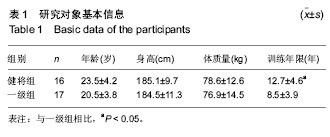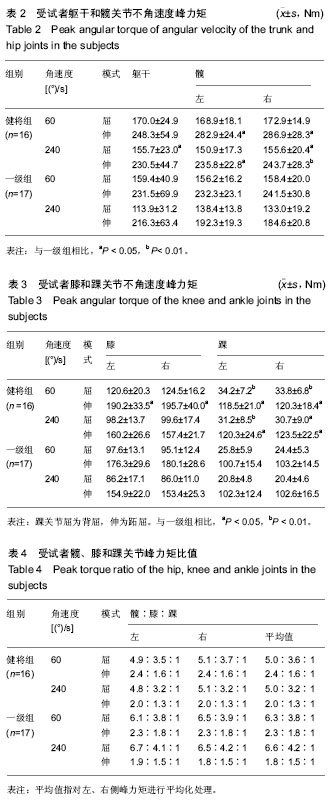中国组织工程研究 ›› 2018, Vol. 22 ›› Issue (12): 1835-1840.doi: 10.3969/j.issn.2095-4344.0200
• 口腔组织构建 oral tissue construction • 上一篇 下一篇
篮球运动员躯干和下肢等速肌力分析
杨雪清1,程 亮2
- 1西华大学体育学院,四川省成都市 610039;2四川省运动技术学院康复中心,四川省成都市 610041
Isokinetic strength of the trunk and lower limbs in basketball players
Yang Xue-qing1, Cheng Liang2
- 1Sports College of Xihua University, Chengdu 610039, Sichuan Province, China; 2Rehabilitative Center of Sichuan Institute of Sports Skills, Chengdu 610041, Sichuan Province, China
摘要:
文章快速阅读:
.jpg) 文题释义:
等速肌力测试:等速运动为可调节抗阻运动或恒定角速度运动,等速运动环节中每一点的阻力负荷与其相应的肌力形成了最佳匹配-较好地完成肌力训练。通过感应系统获得有关肌力变化的各种参数,从而客观量化地完成肌力测试。等速肌力测试是肌力测试的一次重大创新,因能测试受试者关节或关节链不同角速度、运动角度的肌力参数,精确判断被测试部位肌群用力的情况,对判断受试者力量素质、预防运动损伤有积极意义。
耐力素质:指人体在长时间进行工作或运动中克服疲劳的能力,也是反映人体健康水平或体质强弱的一个重要标志。主要包括发展有氧耐力和无氧耐力。
文题释义:
等速肌力测试:等速运动为可调节抗阻运动或恒定角速度运动,等速运动环节中每一点的阻力负荷与其相应的肌力形成了最佳匹配-较好地完成肌力训练。通过感应系统获得有关肌力变化的各种参数,从而客观量化地完成肌力测试。等速肌力测试是肌力测试的一次重大创新,因能测试受试者关节或关节链不同角速度、运动角度的肌力参数,精确判断被测试部位肌群用力的情况,对判断受试者力量素质、预防运动损伤有积极意义。
耐力素质:指人体在长时间进行工作或运动中克服疲劳的能力,也是反映人体健康水平或体质强弱的一个重要标志。主要包括发展有氧耐力和无氧耐力。
.jpg) 文题释义:
等速肌力测试:等速运动为可调节抗阻运动或恒定角速度运动,等速运动环节中每一点的阻力负荷与其相应的肌力形成了最佳匹配-较好地完成肌力训练。通过感应系统获得有关肌力变化的各种参数,从而客观量化地完成肌力测试。等速肌力测试是肌力测试的一次重大创新,因能测试受试者关节或关节链不同角速度、运动角度的肌力参数,精确判断被测试部位肌群用力的情况,对判断受试者力量素质、预防运动损伤有积极意义。
耐力素质:指人体在长时间进行工作或运动中克服疲劳的能力,也是反映人体健康水平或体质强弱的一个重要标志。主要包括发展有氧耐力和无氧耐力。
文题释义:
等速肌力测试:等速运动为可调节抗阻运动或恒定角速度运动,等速运动环节中每一点的阻力负荷与其相应的肌力形成了最佳匹配-较好地完成肌力训练。通过感应系统获得有关肌力变化的各种参数,从而客观量化地完成肌力测试。等速肌力测试是肌力测试的一次重大创新,因能测试受试者关节或关节链不同角速度、运动角度的肌力参数,精确判断被测试部位肌群用力的情况,对判断受试者力量素质、预防运动损伤有积极意义。
耐力素质:指人体在长时间进行工作或运动中克服疲劳的能力,也是反映人体健康水平或体质强弱的一个重要标志。主要包括发展有氧耐力和无氧耐力。摘要
背景:当前研究尚缺乏不同运动等级优秀女子篮球运动员等速肌力的比较性数据。
目的:观察优秀女子篮球运动员躯干和下肢关节肌力特征,比较健将和一级运动员肌力的差异。
方法:采用德国IsoMed 2000等速肌力测试仪,测试16名四川省(一级组)和17名国家队(健将组)优秀女子篮球运动员躯干和下肢关节不同角速度[60 (°)/s,5次;240 (°)/s,25次]的屈、伸肌力。
结果与结论:①健将组右髋伸肌绝对力和屈肌爆发力,双侧膝屈、伸肌绝对力和右侧屈爆发力,双侧踝关节屈、伸肌绝对力和爆发力显著大于一级组(P < 0.05);躯干屈肌爆发力,左髋伸肌绝对力、爆发力和右髋伸肌爆发力非常显著大于一级组(P < 0.01);②髋、膝和踝关节屈、伸肌力比:健将组屈肌绝对力5.0∶3.6∶1,屈肌爆发力5.0∶3.2∶1,伸肌绝对力2.4∶1.6∶1,伸肌爆发力2.0∶1.3∶1;一级组屈肌绝对力6.3∶3.8∶1,屈肌爆发力6.6∶4.2∶1,伸肌绝对力2.3∶1.8∶1,伸肌爆发力1.8∶1.5∶1;③健将组的躯干爆发力,双侧髋、膝绝对力和爆发力的拮抗/主动肌比值与一级组有显著差异(P < 0.05);④健将组和一级组下肢关节异侧同名肌差异均< 10%;⑤健将组躯干屈、伸肌,双侧髋伸肌和双侧踝伸肌耐力显著大于一级组(P < 0.05);⑥结果提示,随着测试角度增加,健将组和一级组躯干和下肢屈、伸峰力矩不同程度下降;健将组和一级组下肢异侧同名肌差异< 10%;一级组需重视躯干屈肌爆发力,髋屈、伸肌绝对力和爆发力、膝伸肌绝对力和踝屈、伸绝对力和爆发力练习,同时需重视躯干屈、伸肌,髋和踝伸肌群的耐力训练。
中国组织工程研究杂志出版内容重点:组织构建;骨细胞;软骨细胞;细胞培养;成纤维细胞;血管内皮细胞;骨质疏松;组织工程
ORCID: 0000-0002-3169-9278(杨雪清)
中图分类号:



.jpg)
.jpg) 文题释义:
等速肌力测试:等速运动为可调节抗阻运动或恒定角速度运动,等速运动环节中每一点的阻力负荷与其相应的肌力形成了最佳匹配-较好地完成肌力训练。通过感应系统获得有关肌力变化的各种参数,从而客观量化地完成肌力测试。等速肌力测试是肌力测试的一次重大创新,因能测试受试者关节或关节链不同角速度、运动角度的肌力参数,精确判断被测试部位肌群用力的情况,对判断受试者力量素质、预防运动损伤有积极意义。
耐力素质:指人体在长时间进行工作或运动中克服疲劳的能力,也是反映人体健康水平或体质强弱的一个重要标志。主要包括发展有氧耐力和无氧耐力。
文题释义:
等速肌力测试:等速运动为可调节抗阻运动或恒定角速度运动,等速运动环节中每一点的阻力负荷与其相应的肌力形成了最佳匹配-较好地完成肌力训练。通过感应系统获得有关肌力变化的各种参数,从而客观量化地完成肌力测试。等速肌力测试是肌力测试的一次重大创新,因能测试受试者关节或关节链不同角速度、运动角度的肌力参数,精确判断被测试部位肌群用力的情况,对判断受试者力量素质、预防运动损伤有积极意义。
耐力素质:指人体在长时间进行工作或运动中克服疲劳的能力,也是反映人体健康水平或体质强弱的一个重要标志。主要包括发展有氧耐力和无氧耐力。